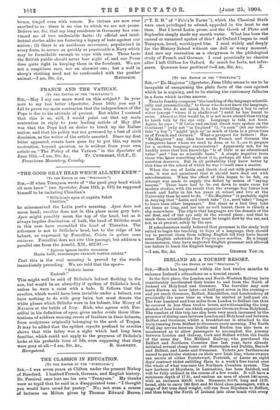SIR,—If when Tennyson wrote of "the good gray head which
all men knew" (see Spectator, June 11th, p. 918) he supposed himself to be imitating Claudian's
" Stilichonis apex et cognita fulsit Canities,"
he misconceived the Latin poet's meaning. Apex does not mean head; canities does not in this place mean grey hair. Apex might possibly mean the top of the head, but as it always implies diminution of bulk, the head of Stilicho must in this case have resembled the head of Thersites. The reference is not to Stilicho's head, but to the ridge of his helmet, as expressed by Forcellini, Crista in galeae cono eminens. Forcellini does not cite this passage, but adduces a parallel one from the Aeneid, XII., 492-93 :— " Apicem tomen incita summum Haste tulit, summasque excussit vortice crista.s."
l'hat this is the real meaning is proved by the words immediately preceding. We are told that the apex- " Sideris instar Emicuit."
This might well be said of Stilicho's helmet flashing in the sun, but would be an absurdity if spoken of Stilicho's head, unless he were a saint with a halo. It follows that the canities, which would have been invisible under a helmet, can have nothing to do with grey hairs, but must denote the white plume which Stilicho wore in his helmet, like Henry of Navarre at the battle of Ivry. Rich, who agrees with For- cellini in his definition of apex, gives under crista three illus- trations of soldiers wearing crests of feathers in their helmets, from sculptures originally belonging to the arch of Trajan. It may be added that the epithet cognita prefixed to canities shows that this latter was a sight which had long been familiar, which could not apply to the greyness of Stilicho's locks at his probable time of life, even supposing that they were grey at all.—I am, Sir, &c., R. GARNETT.
Hampstead.
THE CLASSICS IN EDUCATION.


























































 Previous page
Previous page